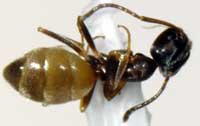Characteristics:
- Brown coloration
- Body 1/8 inch in length
- Workers are all one size (monomorphic)
- Antennae have twelve segments and no antennal club
- Mandibles with two apical teeth, followed by a number of smaller teeth
Colonies vary in size and range from a few hundred to 10,000 individuals, usually with multiple queens. The developmental time of progeny varies seasonally. Egg incubation takes 11-26 days, the larval stages last 13-29 days, and the pre-pupal and pupal stages last 10-24 days. Sexual forms are produced only in colonies that are at least four to five years old. Mating may take place within the nest or nearby. Colonies multiply when one or more fertile females accompanied by numerous workers leave the parent colony, find a new nest, and start a new colony. Single inseminated queens from nuptial flights also may establish new colonies independently.
Distribution
The odorous house ant, Tapinoma sessile (Say), is a native species that occurs throughout the United States. It ranges from Canada to Mexico but is rarely found in the southwestern desert areas. Odorous house ants are highly adaptable and capable of establishing nests in diverse environments from sandy beaches to open fields, woodlands, bogs and homes. Outside, it commonly nests in soil beneath most any object, including stones, logs, concrete blocks, and fallen limbs. It also nests under the bark of logs and stumps and in plant cavities, refuse piles, under mulch in flower beds, and nests of birds and animals. These ants are highly mobile and move frequently from nests that are not well structured.
Management
It is critical to survey inside and outside to locate all nests. Colonies living indoors in wall voids can be treated by injecting an aerosol or dust insecticide into cracks around baseboards, cabinets, door frames, and around electrical switches and plugs. Nests found outside can be drenched with a residual insecticide. When numerous ants appear around the building foundation, a perimeter treatment with a residual insecticide may repel foraging workers and prevent them from re-infesting the structure. Baits that have a protein or sugar-based attractant may be effective when the nest is not accessible.